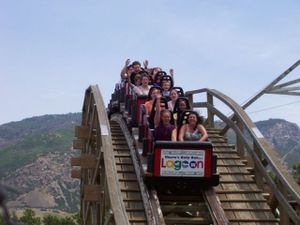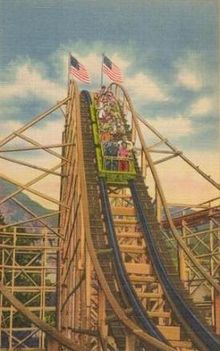Roller Coaster

|
|---|
| Location: Main Midway |
| Built In: 1921 |
| Designed By: John Miller |
| Built By: Miller and Baker, Inc. |
| Highest Height: 62 Feet |
| Track Length: 3,598 Feet |
| Duration: 1 Minute 56 Seconds |
| Speed: 45 MPH |
| # of Trains: 2 |
| Train Capacity: 24 (4 cars of 6 people) |
| Train Manufacturer: Philidelphia Tobaggan Coasters, Inc. |
| Train Style: "3 Seat" or 3 Bench Type |
| Ride Capacity: 1,920 riders per hour |
| Height Requirements: Riders under 46" in height may not ride. Riders between 46" and 50" must be accompanied by a responsible person. |
 |
Roller Coaster is a 1921 classic wooden roller coaster. The ride currently ranks as the 6th oldest roller coaster still in operation.[1]
Ride Details
The ride is a classic wooden roller coaster. The ride's structure and track are made of wood, with a metal plate placed over the wooden track for the train's wheels to ride on. It is not as smooth as modern steel roller coasters, and that is part of its appeal. It is a "double out and back" design that travels away from, and back towards the station two times. The majority of the ride is located in the middle of Lagoon's parking lot. There is a pedestrian walkway underneath the center of the ride to allow for easier access to the campground.
Name
The original name of the ride is not exactly clear and it has been called by several names over its lifetime. The ride was called "Pippin Dips" in a 1923 John Miller catalog. (The ACE plaque at the ride's exit misspells this as Pippen Dips). Old postcards from the 1930's call the ride "Giant Roller Coaster". The ride is also believed to have been known as Lagoon Dips and Lagoon Dipper. For several decades the ride has colloquially been known as "The White Roller Coaster", although the name is being used less frequently now that the ride is being reverted to its original color. The official name of the ride is Roller Coaster.
History

Lagoon's Roller Coaster was designed by the legendary coaster designer John A. Miller, and constructed by Miller and Baker, Inc., a joint venture between John A. Miller and Harry C. Baker, another legendary coaster designer who designed and built the famous Coney Island Cyclone. Roller Coaster opened on May 28, 1921, with at least one open front train, and quickly became one of the most popular rides at Lagoon. The ride was originally a natural brown color.
After the Fire of 1953, when the lift, station, and most of Lagoon was destroyed, Lagoon rebuilt the burned portions of the Roller Coaster and painted the ride white. This is also most likely when Lagoon purchased at least one Century Flyer Roller Coaster Train from National Amusement Device Co., (NAD) of Dayton, Ohio. The Century Flyer trains were often considered the best roller coaster trains of the day and featured a stainless steel skin with headlights on the front with a simple locking lap bar and padded seats.
Modern Changes
It is not known when Lagoon replaced the NAD Century Flyer trains with the current Philadelphia Toboggan Company (PTC) 3 seat trains with one handrail (called buzz bars because of the buzzing sound they make when unlocked) per row. It is also unknown when Lagoon added a second train and switched from manual skid brakes to the modern fin brakes in use today. Lagoon did replace the buzz bars with individual ratcheting lap bars in 1990.
Sheep grazed under the coaster's structure until around the year 2000.
In 2001, Lagoon replaced the old Computer Controlled Safety System with a new PLC Safety System and also built and installed an all steel automatic transfer track. The old transfer track had to be manually moved into place, which made taking on or taking off a train time consuming. Now a train can be taken off or put on the transfer track in under 5 minutes.
In 2004, Lagoon posted signs in the queue line and around the fence in the parking lot stating that they were no longer going to paint the structure white, but let the ride return to it's natural brown color as parts of it are slowly replaced.
In 2008, Lagoon upgraded roller coaster's old PTC ratcheting lap bars, with a newer individual ratcheting lap bar from PTC, and installed what appeared to be an on board lap bar position safety system, much like the ones used on Wicked trains, on one train
In 2009, both trains had a grey box on the back of each car with 6 Green LED lights in 2 rows that light up when a lap bar is down. Lagoon also installed a new lighted sign for the ride, added rock work over the walls, and installed a small planter around the new sign.
Awards
American Coaster Enthusiasts gave Roller Coaster its Coaster Landmark Award. Lagoon placed the ACE Coaster Landmark Plaque on Roller Coaster's Exit Platform next to the Platform Exit in 2007. The plaque reads:
The American Coaster Enthusiasts recognizes Lagoon Park's Roller Coaster as an ACE Roller Coaster Landmark, a designation reserved for rides of historical significance.
Originally named the Lagoon Dips or Pippen Dips, and later the Giant Coaster, the 62-foot tall double out-and-back ride was engineered by master designer John A. Miller (1874-1941) of the New York firm Miller & Baker, and built by the Colorado Construction Company. One of only 13 remaining examples of Miller's work worldwide, it was constructed at a cost of $75,000, and opened on May 28, 1921 with an initial drop of 57 feet and track length of 3,598 feet. An August 1923 flood damaged the structure requiring new concrete footings, and an eclectic new station was added following a November 1953 fire that damaged parts of the midway.
Representing Utah's only traditional wood coaster since 1958, its distinctive structure, stretching from the midway into the adjacent parking area, seems ideally set against the striking backdrop of the Wasatch Mountains. As the sixth oldest coaster in the world, Roller Coaster continues to thrill riders of all ages and remains an integral part of Lagoon's appealing collection of roller coasters.
Presented by American Coaster Enthusiasts - July 30, 2005
Gallery
-
Roller Coaster when it was all white in the late 1990s.
Videos
See Also
Accidents and incidents at Lagoon
References
